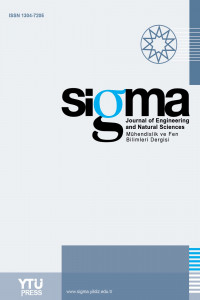Abstract
The aim of this study was to assess the conventional coagulation/flocculation treatability efficiency and the toxicity effect of chemically treated effluent on Daphnia magna for fur-suede processing wastewater. Three different conventional coagulants (FeCl3, Al2SO4, FeSO4) were used in this study and the best treatability conditions (coagulant type and dosage) were determined based on COD and Color removal efficiencies. After then, toxicity determination of raw and chemically best treated fur-suede processing wastewater were done using with Daphnia magna standard method. The results indicated that while the highest COD removal efficiency was determined for Al2SO4 as 86 % at 800 mgL-1 and pH=8.5, the lowest efficiency was found as 67 % for the same dosage of FeCl3 . On the other hand, Color removal efficiencies were found as 95-98 % for all coagulants and the best results was observed at Al2SO4 at 800 mgL-1 and pH=8.5. By the way, the best toxicity removal was calculated as 60% for effluents (50% diluted) treated with Al2SO4. These results show that as a first treatment step for fur-suede processing wastewater, chemical coagulation-flocculation with Al2SO4 provide the best performance both to remove COD and Color and also to decrease in toxic effect.
References
- [1] Yıldız Töre G., Insel G., Ubay Çokgör E., Ferlier E., Kabdaşlı I., Orhon D. (2011) Pollution profile and biodegradation characteristics of fur-suede processing effluents, Environmental Technology, 32(10), 1151-1162.
- [2] Suresh V., Kanthimathi M., Thanikaivelan P., Raghava Rao J., Unni Nair B. (2001) An improved product-process for cleaner chrome tanning in leather processing, Journal of Cleaner Production, 9, 483–491.
- [3] Nazer D. W., Al-Sa’ed R. M., and Siebel M. A. (2006) Reducing the environmental impact of the unhairing–liming process in the leather tanning industry, Journal of Cleaner Production, 14 , 65–74.
- [4] Oral R., Meriç S., De Nicola E., Petruzzelli D., Della Rocca C., Pagano G. (2007) Multi-species toxicity evaluation of a chromium-based leather tannery wastewater, Desalination 211: 48–57.
- [5] De Nicola E., Meriç S., Della Rocca C., Gallo M., Iaccarino M., Manini P., et al. (2007) Wastewater toxicity of tannin- vs. chromium-based leather tanneries in Marrakesh Morocco, Archives of Environmental Contamination and Toxicology 53(3), 321–328.
- [6] Jochimsen J.C., Jekel M.R. (1997) Partial oxidation effects during the combined oxidative and biological treatment of separated streams of tannery wastewater, Water Science Technology 35, 337–345.
- [7] Lofrano G., Meriç S., Zengin G.E. Orhon D. (2013) Chemical and biological treatment technologies for leather tannery chemicals and wastewaters: A review, Science of the Total Environment 461-462, 265-281.
- [8] Boller M. (1993) Removal of organic matter by physicochemical mechanism in wastewater treatment plants, Water Science Technology 27, 167–183.
- [9] Ates E., Orhon D., Tunay O. (1997) Characterization of tannery wastewaters for pretreatment selected case studies, Water Science Technology 36, 217–23.
- [10] Kabdasli I., Tunay O., Orhon D. (1999) Wastewater control and management in a leather tanning district, Water Science Technology 40, 261–7.
- [11] Song Z., Williams C.J. and Edyvean R.G.J. (2004) Treatment of tannery wastewater by chemical coagulation, Desalination 164: 249–59
- [12] Hernando M.D., Fernandez-Alba A.R., Tauler R., Barcelo D. (2005) Toxicity assays applied to wastewater treatment, Talanta 65, 358- 366.
- [13] Villegas-Navarro A., Romero Gonzalez M.C. and Rosas Lopez E. (1999) Evaluation of Daphnia magna as an indicator of toxicity and treatment efficacy of textile wastewater, Environmental International 25, 619- 624.
- [14] US Environmental Protection Agency (1979), Development document for effluent limitations guidelines and standards. Leather tanning and finishing point sources category, EPA 440/1-79/016, US EPA, Washington, DC.
- [15] Tunay O., Kabdaşlı I., Orhon D., Ateş E. (1995) Characterization and pollution profile of leather tanning industry in Turkey, Water Science Technology 32, 1–9.
- [16] APHA-AWWA-WEF (1998), Standard Methods for the Examination of Water and Wastewater. American Public Health Association/American Water Works Association/Water Environment Federation 20th edition, Washington DC, USA.
- [17] ISO 6060 (1986), Water Quality−Determination of the Chemical Oxygen Demand, ISO (International Organisation for Standardisation, Geneva, Switzerland), Reference No: 6060.
- [18] ISO 7887 (1994), Water quality-determination of color, ISO (International Organisation for Standardisation, Geneva, Switzerland) Reference No: 7887.
- [19] ISO (1996), Water quality: determination of the inhibition of the mobility of Daphnia Magna Starus (cladocera, Crustacea)- Acute toxicity test. ISO (International Organisation for Standardisation, Geneva, Switzerland) Reference No: 66431.
- [20] Nicola E. De, Gallo M., Iaccarino M., Meriç S., Oral R., Russo T., Sorrentino T., Tünay O. Vutta riello E., Warnau M., Pagano G. (2004) Hormetic vs. toxic effects of vegetable tannin in a multi-test study, Archive of Environmental Contamination Toxicology 46, 336–345.
- [21] Reemtsma T. and Jekel M. (1997) Water Research, 31(5), 1035-1046.
- [22] Song Z., Williams C. J., R. G. J. (2001) Coagulation and Anaerobic Digestion of Tannery Wastewater Trans. Iournal of Chemical Engineer 79, Part B.
- [23] Kaptan, D. (2002), Toxicity removal at textile wastewaters, Master Science Thesis, Department of Environmental Engineering, Istanbul Technical University.
- [24] Lofrano G., Belgiorno V., Gallo M., Raimo A., Meriç S. (2006) Toxicity reduction in leather tanning wastewater by improved coagulation flocculation process, Global Nest Journal 8,151–8.
- [25] Lofrano G., Aydin E., Russo F., Guida M., Belgiorno V., Meric S. (2008) Characterization, Fluxes and Toxicity of Leather Tanning Bath Chemicals in a Large Tanning District Area (IT), Water, Air, & Soil Pollution, Focus 8 (5), 529-542.
Details
| Primary Language | English |
|---|---|
| Subjects | Engineering |
| Journal Section | Research Articles |
| Authors | |
| Publication Date | March 1, 2018 |
| Submission Date | September 5, 2017 |
| Published in Issue | Year 2018 Volume: 36 Issue: 1 |
IMPORTANT NOTE: JOURNAL SUBMISSION LINK https://eds.yildiz.edu.tr/sigma/

